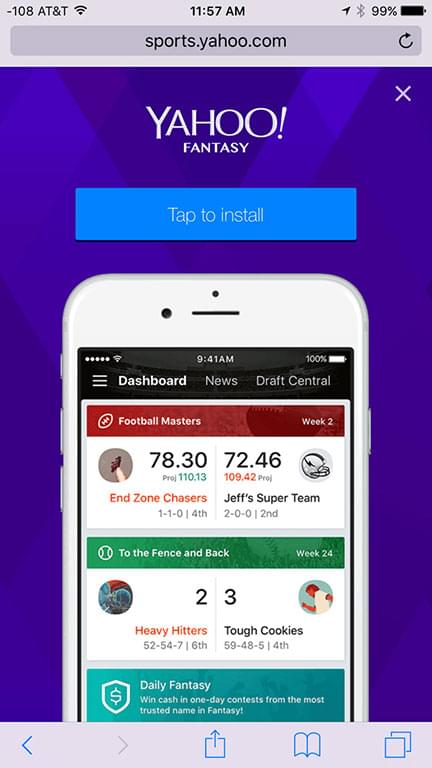Google’s Interstitial Ad Penalty and Its Effect on Mobile Marketers
 Last year, Google put digital marketers on notice that a deep freeze was coming for interstitial ads. Now, the search giant has officially put them out in the cold, a move that will open opportunities for marketers willing to create a better mobile experience for consumers.
Last year, Google put digital marketers on notice that a deep freeze was coming for interstitial ads. Now, the search giant has officially put them out in the cold, a move that will open opportunities for marketers willing to create a better mobile experience for consumers.
Starting January 10, 2017, Google will institute what some observers are calling a “pop-up penalty,” targeting ads that hide or gray-out most or all of a mobile screen. Websites displaying the intrusive advertisements on mobile devices may not rank as highly in search results. It’s a change that will leave a significant footprint; mobile use drives about 56 percent of consumer traffic to top U.S. websites, according to SimilarWeb’s State of Mobile Web in the U.S. 2015 report.
The move isn’t exactly a surprise; in 2015, the search engine giant announced it would penalize websites that displayed interstitial ads prompting users to download an app. Soon after, Apple gave Safari users the ability to install ad blocker apps that would stop interstitials on iPhones and iPads.
It’s important to note that Google will penalize a website in mobile search results only, which seems appropriate given the challenge of navigating the intrusive ads on screens as small as 4.5 inches versus ads viewed on a laptop or desktop. What’s more, interstitial advertising remains one of many signals the search engine uses to assess ranking.
However, don’t expect these mobile pop-ups to disappear completely. If you’re a company using them for age verification, cookie usage, or paywall logins, Google won’t ding you in search results. It also won’t impose a penalty if your business displays mobile banners that are easy to dismiss and don’t take up a large amount of screen space.
Ditching the Frustration Factor
Is everybody happy about the crackdown on these often-frustrating ads? No. Some view Google’s actions over the last year, particularly the decision to penalize app interstitials, as indication it’s creating a monopoly on search.
Yet it seems clear that intrusive interstitials degrade the user experience. For example, Google itself found that 69 percent of users who were shown an interstitial ad for a Google+ app download abandoned the visit completely.
Likewise, outside research suggests the ineffectiveness of this type of ad. Using tools like eye tracking and wireless EEG, researchers found that people looked at mobile banner ads for 200 milliseconds and interstitial ads for 800 milliseconds.
Does that suggest users are more drawn to interstitial ads? Not necessarily. The mobile marketing research, conducted by Spark Experience and WPP agency Light Reaction, discovered that while people viewed interstitials for a slightly longer period of time, most of that was spent looking for the teeny-tiny “X” to close the ad.
Creating Opportunities in a Post-Interstitial World
Anyone who has struggled to find that elusive close button on a mobile ad knows firsthand that Google’s penalty will make mobile search less frustrating. But it will open opportunities for marketers as well. If you’re using large interstitials and pop-ups in your digital advertising efforts, this is the perfect time to reassess and refine your mobile strategy to maximize user experience. Here are two ways to build a better experience in a post-interstitial world:
Develop a content marketing strategy
The consistent creation and distribution of relevant content attracts users without beating them with a hard-sell stick. Use content—including blog posts, round-ups, guides, videos, infographics, and more—to educate audiences and guide them through the buying process.
Don’t fear long-form content, either, even if your audience is primarily using mobile. Pew Research Center found that long-form content, such as articles of 1,000 words or more, attracts small-screen users at about the same rate as its shorter counterpart. Consumers also tend to engage with long-form articles for more than twice as long as short pieces.
Whether your target audience prefers short videos or long-form articles, make sure the content provides value to the user so it retains their attention and activates engagement.
Ensure an overall friendly mobile experience
Mobile friendliness is no longer a web design afterthought; it’s a best practice. Keep eyeballs on the website by designing a hassle-free experience for users, whether they’re your consumers, clients, employees, business partners, or investors.
- Make text on mobile devices readable without the need to pinch-zoom.
- Keep navigation easy and menus simple.
- Incorporate fluid layouts to accommodate screens of various sizes.
- Create simplified forms using a minimal number of fields.
Update to the latest Mobile Ads SDK
One of the best ways app developers can avoid the pitfalls associated with inappropriate ad types is to integrate the latest software development kits (SDKs) into their apps. Google offers its SDKs for iOS and Android for free. Although these still allow interstitials to be used, they offer guidelines that can help app developers determine whether their content qualifies for an interstitial (in the case of age verification, for example) and whether they will present a poor user experience if they are installed.
References and Further Reading:
Winter is coming for the digital marketing industry:
http://www.business.com/online-marketing/winter-is-coming-for-the-digital-advertising-industry/
Google: Helping users easily access content on mobile:
https://webmasters.googleblog.com/2016/08/helping-users-easily-access-content-on.html
Mobile Devices Now Driving 56 Percent of Traffic to Top Sites:
http://marketingland.com/mobile-top-sites-165725
Google: Data Show Users Hate App-Promotion Interstitials:
http://marketingland.com/google-data-show-users-hate-app-promotion-interstitials-136339
Mobile Ad Study Finds Interstitials Only Slightly Better Than Banners for Being Seen:
http://www.adweek.com/news/technology/mobile-ad-study-finds-interstitials-only-slightly-better-banners-being-seen-171980
Long Form Reading Shows Signs of Life in Our Mobile News World:
http://www.journalism.org/2016/05/05/long-form-reading-shows-signs-of-life-in-our-mobile-news-world/
Google: Interstitial Ad Guidance:
https://support.google.com/admob/answer/6066980?hl=en-GB